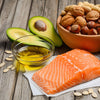How a Low-Carb, High-Fat Lifestyle Can Help End Yo-Yo Dieting


Anyone who has tried at least one diet plan is probably familiar with the yo-yo effect – a term commonly used to describe those exasperating cycles of weight loss and regain. At the start of a new diet or different exercise program, individuals often see great results. However, improvements typically wane after a few weeks, resulting in the dreaded plateau and numbers on a scale that creep back up to, or even above, their original weight. Furthermore, recent research suggests this pattern isn’t just frustrating, but also a serious potential health threat. A study in the New England Journal of Medicine concluded that “fluctuation in body weight was associated with higher mortality and a higher rate of cardiovascular events independent of traditional cardiovascular risk factors.”1
So why do we get stuck in this rut of ups and downs? Our bodies’ own survival mechanisms are to blame. We tend to think of our metabolism as a simple bank account of calories. When we lose substantial amounts of weight, our metabolic rate starts to slow down,2,3 meaning we don’t burn as many calories throughout the day. Fat loss also tends to increase circulating levels of appetite hormones,4 making hunger and cravings even worse. A high-fat, low-carb diet shows promise as a sustainable means of weight-maintenance by addressing these two critical factors: (1) Maintaining metabolic rate and (2) Attenuating drastic fluctuations in appetite hormones.
Cutting the string on the yo-yo effect
Researchers wanted to examine the effects of dietary composition on energy expenditure during weight-loss maintenance by comparing 3 different diets differing in macronutrient composition and glycemic load. The study involved 21 overweight adults who were followed between 2006 and 2010. After achieving 10%-15% weight loss, the participants followed an isocaloric low-fat diet (60% of calories from carbohydrates, 20% from fat, and 20% from protein; high glycemic load), a low glycemic index diet (40% from carbohydrates, 40% from fat, and 20% from protein; moderate glycemic load), and a very-low carbohydrate diet (10% from carbohydrates, 60% from fat, and 30% from protein; low glycemic load) in random order for 4 weeks.
Compared with the pre-weight loss baseline measurements: the low-fat diet had the greatest decrease in resting energy expenditure followed by the intermediate low-glycemic index diet and the low-carbohydrate diet had the smallest decrease in resting energy expenditure.5 The decrease in total energy expenditure also followed a similar pattern. In other words, the low-carb, high-fat diet resulted in the smallest decrease in the participants’ metabolic rate.
As previously mentioned, diet-induced weight loss is accompanied by compensatory changes in circulating concentrations of appetite-inducing hormones. A study was conducted to examine the effects of ketosis on a number of circulating factors involved in appetite regulation following diet-induced weight loss. Thirty-nine overweight subjects completed an 8-week ketogenic diet followed by a 2-week reintroduction of foods. Circulating concentrations of glucose, insulin, non-esterified fatty acids, beta-hydroxybutyrate, leptin and subjective ratings of appetite were compared when subjects were ketotic and after re-feeding. During the ketogenic diet, subjects lost 13% of initial weight and fasting BHB increased. While the participants were ketotic, the weight loss induced increase in ghrelin was suppressed. Glucose and NEFA were higher while leptin and subjective ratings of appetite were lower at week 8 compared to after re-feeding. Circulating concentrations of several hormones and nutrients which influence appetite were altered after weight loss induced by a ketogenic diet compared with after re-feeding. Increases in circulating ghrelin and subjective appetite which accompany weight loss were reduced when patients were ketotic.6 This study showed that a low-carb, high-fat diet could be an effective way for countering the elevated levels of appetite-inducing hormones that are typically associated with weight loss.
How can PrimaForce help?
For anyone thinking of making a change towards real and sustainable improvements, PrimaForce offers convenient meal and snack options to help equip any low-carb, high-fat lifestyle. The PrimaForce KetoShakes are a delicious and satisfying meal replacement option that can replace one meal per day with a careful formulation of MCTs and grass-fed whey protein. If cravings start to distract you in between meals or you find yourself hitting an afternoon slump, you can reach for PrimaForce BHB. By offering exogenous beta-hydroxybutyrate (BHB), BHB provides an alternative fuel to the glucose found in sugary sports drinks and soda.2
References
| 1. | Bangalore, S. et al. Body-Weight Fluctuations and Outcomes in Coronary Disease. N. Engl. J. Med. 376, 1332–1340 (2017). |
| 2. | Fothergill, E. et al. Persistent metabolic adaptation 6 years after ‘The Biggest Loser’ competition. Obesity 24, 1612–1619 (2016). |
| 3. | Dulloo, A. G. & Jacquet, J. Adaptive reduction in basal metabolic rate in response to food deprivation in humans: a role for feedback signals from fat stores. Am. J. Clin. Nutr. 68, 599–606 (1998). |
| 4. | Dulloo, A. G., Jacquet, J. & Montani, J.-P. How dieting makes some fatter: from a perspective of human body composition autoregulation. Proc. Nutr. Soc. 71, 379–389 (2012). |
| 5. | Ebbeling, C. B. et al. Effects of Dietary Composition on Energy Expenditure During Weight-Loss Maintenance. JAMA 307, 2627–34 (2012). |
| 6. | Sumithran, P. et al. Ketosis and appetite-mediating nutrients and hormones after weight loss. Eur. J. Clin. Nutr. 67, 759–764 (2013). |




